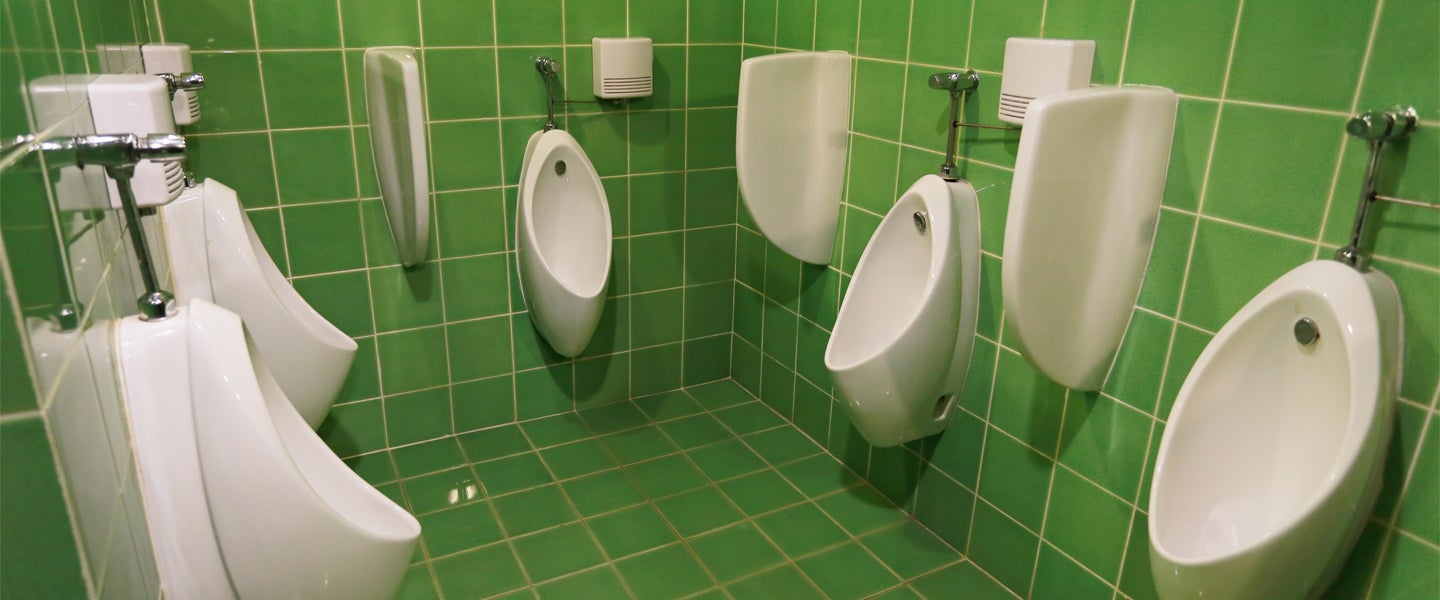Ah, the public urinal, that magical place where your piss goes to mingle with other people’s piss. Sure, the lighting, the color of the walls and the amount of feces that’s smeared across the floor differs from one public bathroom to the next, but a single detail almost always holds true: The splashback you feel sprinkling against your leg is always a bit of your bodily fluids, mixed with some other person’s bodily fluids.
Because really, how many of us feel the need to flush after using a urinal? Unless, of course, you’re the president, and you feel the need to flush “10 times, 15 times” each time you evacuate your cavernous bowels. It’s just pee, after all — not a giant, floating toilet baby, swaddled in wads of skidmarked paper. No, the mission with a public urinal is to get in and out as quickly as possible, and that rarely means flushing. Still, once in a while, all of us will stare into that cloudy yellow pool bubbling up at them and wonder to themselves if they should help its passage down the drain.
Before we go any further with discussing when to consider flushing your fellow man’s urea down the drain, though, it’s important to understand what sort of piss cocktail is in there. For the uninitiated, piss is basically water, mixed with the substances excreted by your kidneys: These include nitrogen, phosphorus and potassium; salts; and traces of any pharmaceuticals you happen to be taking, to name a few — more than 3,000 chemical compounds in all. To that end, as I noted in my article on whether it’s okay to leave pee floating in the toilet, despite the received wisdom, pee isn’t exactly sterile after all.
Despite this, splashback might be the least of your worries: Any concerns you might have regarding germs in public bathrooms should stem more from what you’ll encounter on the flush handles. According to a report in CityLab, Americans are, “so frightened of germs that 64 percent of people who use public bathrooms press the toilet flusher with their feet.” Which, frankly, seems like a pretty good argument for also using your feet, considering the floor of the average bathroom.
But wait — that’s the actual toilet, not the urinal. And according to Jason Tetro, author of The Surprising Ways Microbes Can Improve Your Health and Life (and How to Protect Yourself from the Bad Ones), while urinals and floor areas around the urinal are a hub for germs, including fecal bacteria, “the flush handle appears to be rarely contaminated, or doesn’t have high levels of bacteria when it’s found,” says Tetro, citing a 2008 study from the University of Toledo. Tetro admits that there are some skin and environmental bacteria likely found on the handles, but he tells me, “These would be relatively harmless and easily removed with proper handwashing.”
For that reason, Tetro says that it would be “highly unlikely” for someone to contract a disease from touching a bathroom urinal handle. “In order to become ill from most pathogens, one needs to be exposed to numbers that are much higher than what you’d find on a flush handle,” he says. “The only exception might be norovirus from infected individuals.” He adds, however, that the pathogen wouldn’t be transferred merely by someone with the virus touching the handle. “It would most likely be found on a toilet flush handle due to the symptoms [i.e., vomiting] that the infection cause,” says Tetro. But you don’t need to be told not to touch the handle that’s got a stranger’s vomit dripping from it, right?
Germs aside, nearly every reason given by men for not flushing urinals is that they’re trying not to waste water. “Leave it till it’s full, then flush. Save water. Conservation, conservation, conservation,” writes one guy on an ARS Technica forum. Several others agree. “If I step up to one that’s already yellow, I’ll flush when done,” he writes. “If it’s clear, I won’t.”
Which is both reasonable and well-intentioned, especially considering the average toilet uses anywhere from one to three gallons of water for each flush, which means by not flushing every time you pee, you are in fact saving a ton of water. “Newer toilets tend to use less, and older toilets tend to use more, since water efficiency has become a bigger focus in construction in the last few decades,” reports HowStuffWorks. “A single urinal can use anywhere from 20,000 to 45,000 gallons of water each year. That estimate is based on a building with a few dozen male employees each using the urinal three times a day.” Not to mention that according to a report from the Indiana University Newsroom, “flushing tops the list of water-intensive household activities and accounts for 27 percent of indoor usage.”
Though it’s not exactly easy to tell when a public urinal is ripe for flushing — obviously, if it’s overflowing with pee, you’re better off kicking the handle before unleashing your stream into the yellow pool — the good news is that an increasing number of urinals are going waterless, which means you don’t even need to worry about touching anything. “As the waste rises higher than the top of the open drain pipe, the excess trickles down the drain,” reports a different article in HowStuffWorks. “As more men use the urinal, the urine in the well continually flows out through the pipe as new urine displaces it. The urinals are designed in such a way that the flow of urine is continuous from the point it enters the trap until it enters the drain. This allows the waste to drain naturally, without needing to be forced out like a traditional urinal.”
The future, it turns out, is flush-free.

